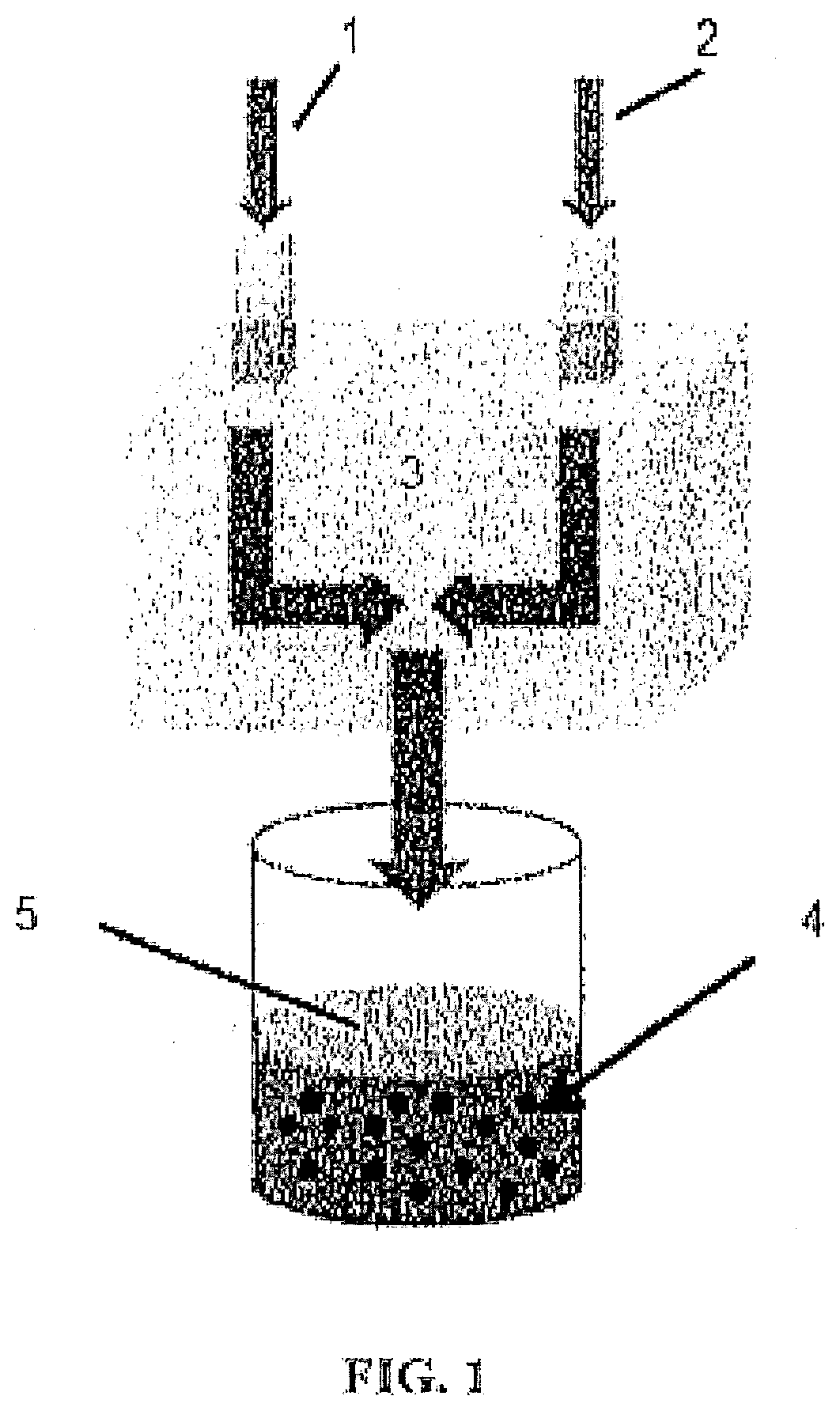Janus particles and their use for surfactant-free cleansing and emulsion stabilization
a technology of surfactant-free cleansing and emulsion stabilization, which is applied in the preparation of detergent mixture compositions, colloidal chemistry, transportation and packaging, etc. it can solve the problems of affecting the development of new technologies, and affecting the application of multi-faced nanocolloids
- Summary
- Abstract
- Description
- Claims
- Application Information
AI Technical Summary
Benefits of technology
Problems solved by technology
Method used
Image
Examples
example 1
of Polystyrene (PS): Polyisoprene (PI) Janus Particle with Amphiphilic Block Copolymer
[0095]The FNP process can be used. Along with polystyrene (PS) and polyisoprene (PI) homopolymers, two amphiphilic block copolymers can be added to a tetrahydrofuran (THF) stream. For example, the polymers can be polystyrene-block-polyethylene oxide (PS-b-PEO) (P9669B1-EOS cleavable from Polymer Source, Canada) and a similar PI-b-PEO at a ratio of 50:50 based on the mass of the PEO block. FNP on the mixture can produce nanoparticles that are stable and for which the solvent can be removed by dialysis. To the resulting nanoparticle sample hydrochloric acid (HCl) can be added to produce a pH of 1.5. After 24 hours the sample can be dialyzed against distilled water to obtain a Janus particle dispersion, essentially free of polyethylene oxide (PEO), with a surface chemistry of pure PI and PS.
example 2
ne Polyisoprene Janus Particles
[0096]Janus nanocolloids of polystyrene (PS; Mw=16,500 g / mol) and polyisoprene (PI; Mw=11,000 g / mol) (χPS-PI=0.07) were Formed (Physical Properties of Polymers Handbook, Springer, 2007, 349-355). Tetrahydrofuran (THF) and water were selected as the solvent and non-solvent, respectively. The process conditions employed, e.g., jet velocity ˜1 m / s and a 1 mm orifice, resulted in a Reynolds number ˜3500. Other mixing velocities, for example, in a range from 0.1 m / s to 30 m / s, resulting in other Reynolds numbers, for example, in a range from 300 to 100,000, can be used. For example, mixing velocities ranging from about 0.1 m / s, 0.3 m / s, 1 m / s, 3 m / s, or 10 m / s to about 0.3 m / s, 1 m / s, 3 m / s, 10 m / s, or 30 m / s can be used. For example, Reynolds numbers can range from about 300, 1000, 3000, 10,000, or 30,000 to about 1000, 3000, 10,000, 30,000, or 100,000. Symmetric Janus nanocolloids with a diameter (d) ˜200 nm were formed. To demonstrate the versatility of ...
example 3
ticles with Varied Polymer End-Group Functionality and Alternative Polymers
[0104]While the surface structure of nanocolloids strongly influences functionality, the material composition of surface domains determines the types of interactions the colloids exhibit with external environments. The PISA-FNP methodology has been extended to two other classes of systems: i) PS-PI Janus nanocolloids with varying polymer end-group functionality; and ii) Janus nanocolloids with new polymer components.
[0105](i) PS-PI Janus nanocolloids were prepared with polymer surfaces containing varying amounts of hydrogen or hydroxyl moieties. This was achieved by using homopolymers with different end-group functionalities in the feed stream, rather than chemically altering the particles post-fabrication. The particles prepared included the following Janus particles: particles prepared with polystyrene and hydroxy-terminated polybutadiene; particles prepared with hydroxy-terminated polystyrene and hydroxy-t...
PUM
| Property | Measurement | Unit |
|---|---|---|
| molecular weight | aaaaa | aaaaa |
| molecular weight | aaaaa | aaaaa |
| diameter | aaaaa | aaaaa |
Abstract
Description
Claims
Application Information
 Login to View More
Login to View More - R&D
- Intellectual Property
- Life Sciences
- Materials
- Tech Scout
- Unparalleled Data Quality
- Higher Quality Content
- 60% Fewer Hallucinations
Browse by: Latest US Patents, China's latest patents, Technical Efficacy Thesaurus, Application Domain, Technology Topic, Popular Technical Reports.
© 2025 PatSnap. All rights reserved.Legal|Privacy policy|Modern Slavery Act Transparency Statement|Sitemap|About US| Contact US: help@patsnap.com



